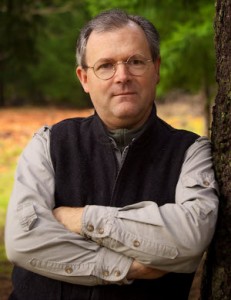 Renowned gunsmith Grant Cunningham has worked on precision machinery since he was a teenager. So when his first revolver needed work and he couldn’t find a gunsmith who would take the job, he did it himself. He progressed from working on his own revolvers to helping others, and today is one of the most sought-after revolversmiths in the country, specializing in double-action revolvers. His current two-year waiting list speaks for the quality of his work.
Renowned gunsmith Grant Cunningham has worked on precision machinery since he was a teenager. So when his first revolver needed work and he couldn’t find a gunsmith who would take the job, he did it himself. He progressed from working on his own revolvers to helping others, and today is one of the most sought-after revolversmiths in the country, specializing in double-action revolvers. His current two-year waiting list speaks for the quality of his work.
The next logical step for Cunningham was to begin teaching others about the revolver and how to use it. The result was his flagship course, Revolver Doctrine.
Today, in addition to doing all his gunsmithing work personally and teaching revolver, AR-15 and Combat Focus Shooting courses, Cunningham shares his perspectives on a variety of relevant topics with readers here at PDN. Our Q&A session focused on his work as a firearms instructor.
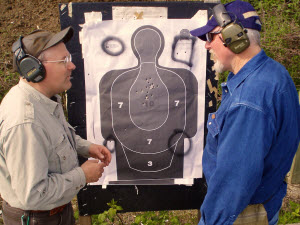
Why did you decide to become a trainer?
I’ve always liked teaching in and of itself. I like exposing people to new things, new ideas, and watching them grow with the realization that they’ve just seen something they can use and something they can do.
Finding the best information or techniques and bringing them to people in a form that they can understand and incorporate in their daily lives are what drive me. The reason I like to teach shooting and self defense specifically is because of the practical application, the possibility that what they learn may someday save their life or the life of a loved one.
It’s both exciting and humbling to realize that I have the opportunity to help people in such a fundamental way. That keeps me energized.
Lots of people teach shooting — in what ways do you teach it differently?
One of the primary differences is that I don’t teach dogmatically. That is, I don’t rely on mantras and nonsensical sayings to support what I teach. Instead I explain the why of the technique, the logic behind it, and then let the student experience that reality.
If I can’t explain it, if I don’t have a rational reason for a technique or a specific kind of equipment, I won’t present it to my students. The last thing I want to do is respond to a student question by name-dropping: “Well, so-and-so does it!” (The implicit argument being “Do you think you’re smarter than he is?”)
A lot of instructors teach via the cafeteria method: they show the student several different ways to do something, then tell them the choice is theirs. I don’t do that. I assume that the student came to my class because he or she wanted to learn what I think is the best way to do something. I’ll give that to them, explain thoroughly why I believe it to be the best way, and if they have an honest problem doing it, I’ll modify the technique just for them. I’m not a believer in the “another tool for the toolbox” philosophy of teaching; everything has to have a purpose that fits a plausible situation.

How do you motivate students to learn while in a class?
In most cases, that’s actually easy. It’s pretty much a given that a student who has spent his/her own money and a big chunk of time to attend a class is motivated to learn — that’s why they’re there! It’s just a matter of connecting with their needs, their goals, and giving the instruction in a form that makes sense to them.
But even the most motivated and engaged student can get a little bored or bogged down, so it’s important that the class be fun, exciting, and yet push them a little bit. There has to be something between the dull six-hour lecture and the exhausting, frustrating boot-camp experience, and that’s where I try to be.
There are exceptions, of course. There are occasionally those individuals who inexplicably come to class not to learn but simply to collect a certificate for their wall. In those cases it’s important to get them to understand why the instruction is of value to them, why it’s worth their attention.
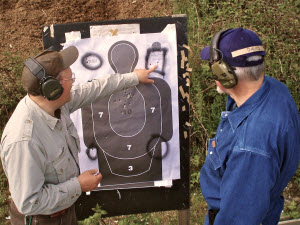
What type of person should your students expect to deal with when they train with you?
I tend to be more thorough than many instructors, explaining both the “big picture” and how each piece fits together and into that picture. I’m very big on students understanding how everything relates to and affects everything else.
Despite having a bit of a reputation for being opinionated, on the firing line I’m more supportive than confrontational. But that isn’t to say I can’t be tough! When it’s necessary for the student’s development, I’ll push them through their self-imposed limitations so that they can see real progress. Of course when it comes to safety issues, there isn’t any tolerance, and I’ve been known to sideline students who have trouble conducting themselves safely.
My students can also expect honest feedback not just on their technique, but also on their equipment. I know that sounds harsh, but it’s my job to identify and correct the student’s deficiencies in their skills, and sometimes their equipment is a big part of the problem. I know a lot of instructors dance around this issue, afraid to confront the student about their buying practices, but I believe that my students seek me out precisely for my opinions, including those that pertain to the stuff they’re using.
One thing most people notice right away is that I don’t use profanity. It’s not that I’m a prude or have any religious hangups. I’ve just always believed that one can make even the most emphatic point without resorting to crudity. (Another instructor once called me “Mr. Clean,” not realizing that I consider it a compliment!)
Who are your inspirations?
I have both inspirations and influences. My main inspiration isn’t even remotely connected to this field: Steve Jobs at Apple. Many years ago, he was the subject of a documentary where he revealed that the reason he did what he did was because it gave him the opportunity to change the way that people learn and see the world. He looks at things not as they are, but as they could be. That’s what I’ve always tried to do, in and out of this field: look at things with a fresh perspective and not be afraid to be different than the rest of the herd.
My main influences in the firearms field have been Gila Hayes and Georges Rahbani. Gila is one of the founders of the Firearms Academy of Seattle, and she impressed upon me the need to consider the student first: what’s best for them, what they truly need (which may be different than what they say they need), and a cognizance of their limitations — real or imagined.
Georges is a local instructor best known for his rifle courses, and a consummate professional who deserves wider recognition. Georges demonstrated to me the need to be prepared, to know your material backward and forward, and how to be stern while still maintaining decorum and civility. He also taught me how to initiate and maintain control over a group — very important when dealing with guns — and the little things that can sabotage your influence with students. It was he who first convinced me that I should pass along what I’ve learned, so it’s fair to say that he’s the reason we’re talking today.
And who do you think are some of the best instructors teaching in your field today?
I’m very uncomfortable labeling anyone as “best,” particularly when there are as many opportunities to be “best” as there are in this field! There are a lot of instructors I respect because they’re among the “best” at some part of the equation; no one is the best at everything. These are the people I admire, some of whom I’ve trained with and others I hope to.
A lot of talented people specialize in the sheer athletic ability of shooting fast with control. Bill Rogers and John Shaw are two of the “old guard” who still have great programs and are very respected by those in the know. Some of the newer guys are really pushing the envelope: people like Larry Vickers and Dave Harrington are among the best at what they do, and Todd Green is making a name for himself in this category as well.
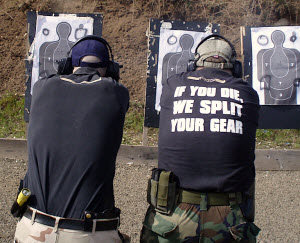 When it comes to reality-based defensive shooting instructors, the people who focus on skills for plausible situations, the field narrows considerably. I think Rob Pincus is at the head of the pack. He’s one of the very few who has really articulated the training difference between the criminal ambush attack and the imagined, stylized attacks that most people prepare for. On the non-firearms side, Tony Blauer has been pioneering the same kind of approach for years.
When it comes to reality-based defensive shooting instructors, the people who focus on skills for plausible situations, the field narrows considerably. I think Rob Pincus is at the head of the pack. He’s one of the very few who has really articulated the training difference between the criminal ambush attack and the imagined, stylized attacks that most people prepare for. On the non-firearms side, Tony Blauer has been pioneering the same kind of approach for years.
The legal and aftermath parts of the self-defense equation are incredibly important yet often overlooked. Massad Ayoob has been around a while, but you’d be hard pressed to find anyone who is as good at teaching that stuff. His courtroom and expert witness experience are formidable.
Marty Hayes is another notable source for this kind of information. Because of their knowledge and dedication to the cause, there is a big gap between them and the next best people in this field.
A list of great instructors would not be complete without one of the most iconoclastic of all the “old guard”: Louis Awerbuck. He’s unique in that his classes don’t involve high round counts, but rather teach how to make each round count. I don’t think anyone has yet duplicated his unique target system that simulates real movement of multiple “persons.” While his classes may be more suited to police or military operations, he has things to teach the armed citizen as well.
I’m glad to see some medical professionals stepping into our field to help counter some of the pervasive myths that have been perpetuated through too many generations of instructors. One of the people at the top of my training wish list is Dr. James Williams, whose concepts of Tactical Anatomy have created something of a buzz in the training community.
Finally, Tom Givens needs to be commended for both his teaching and the tremendous training conferences that he runs. He assembles groups of disparate instructors and allows them to teach the way they want to teach. It takes guts to do that, knowing full well that you’re not necessarily going to agree with everyone you invite to your event. We need more people like him.
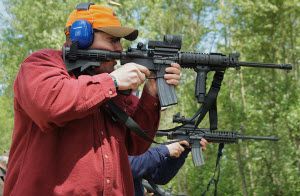
What can students expect to take away from your courses?
The primary goal is that they experience skill development, that they come away knowing something or being able to do something that they didn’t or couldn’t at the start.
At the end of the course, they should realize that they have a duty to themselves to question what they’re being taught, to seek explanation and factual justification for the things they’re told. I’d like them to develop a curious attitude, a desire to continue to learn, as a consequence.
Finally, they should understand that the context and relevance of their training and practice are far more important than the sheer quantity. Not all trigger time is good; it has to be related to a goal.
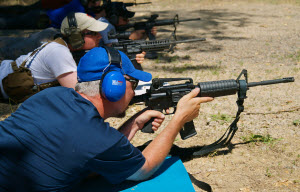
Do you have a “typical” student? What is s/he like?
Most of the people I encounter in class are normal, thoughtful people who just want to learn how to protect themselves and their families. They’re usually not cops or soldiers, and don’t want to be. They just want training that can be implemented in their own environment and that addresses the risks they actually face.
Beyond that, I don’t pay attention to the demographics of my students. A good portion of my professional life was spent managing sales and product development, fields where people are classified and segmented and treated as numbers. It’s pretty dehumanizing to be thought of merely by the group to which one has been assigned!
Instead, I think of my students as the individuals whom I’ve taught: men, women, gay, straight, fat, thin, young, old, Democrat, Republican, new to the topic, and seasoned shooters. Their commonality is that they wanted to take responsibility for their own safety. That’s the best demographic I can imagine!
What’s your training philosophy?
Never be afraid to admit you don’t know something. Bluffing fools no one.
Keep the end in mind. Context is more important than most people believe.
The student is why a teacher exists. Give them what they need, not what you like.
Explain the why as thoroughly as you do the what. If students understand the why, they will remember the what. It doesn’t work as well the other way around.
Pay attention to students’ questions and answer them with integrity.
You’re the expert, the person the students trust. Act like you deserve it.
Don’t promise what you can’t deliver.
Always remain a student. No one is so good that he can’t learn more.
When you stop enjoying the job, quit. A bitter teacher is useless.
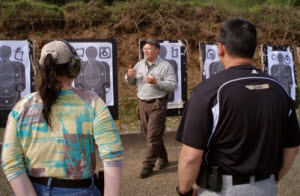
Looking ahead, what do you see in the future for yourself as a trainer?
My main interest is in becoming a better teacher, to continually improve at the art of instruction. I’m not as interested these days in staying on the cutting edge as a shooter or in the equipment race. I’d rather be at the forefront of educational thought and practice. That’s not to say I’ll let my skills atrophy or become blissfully unaware of the latest in ballistics, but I emphasize teaching.
I hope that I can make some small contribution to the body of work that deals with the science — psychology, physiology — of teaching self defense. I’m particularly interested in how to better implement reality-based instruction in a non-dedicated environment. Many people have the idea that reality-based training can only be done in a special (expensive) facility, but I’m of the opinion that it doesn’t happen in a room — it happens in the mind. I’m looking forward to exploring this idea, both theory and application, more deeply in the next few years.
How about for your particular training industry?
The field of integrated combatives is where the next group of teaching stars is going to appear. Ten years ago, you had the gun guys, the knife guys, and the empty-hand guys, with very little overlap. In the last five years particularly, there’s been a shift toward doing more integration: the gun guys have learned to grapple, the grapplers have learned a little about shooting, and so on. Even with that progress, the field is still disjointed and there’s not yet a unified way of looking at the whole of defensive response.
Consequently, there’s still room for growth and innovation, and I believe it’s going to come from the women who teach (and take) self-defense classes. Women desire the same protection from harm that men do — perhaps more so — but in my experience they expect it to be relevant and applicable to the whole of their lives. If they’re not yet driving this movement, they soon will be! For instance, Kelly Muir in Ohio is at the forefront with her whole-system approach to self defense, and I believe she’s going to become very important to all of us who study this stuff.
I think the “old boy’s clubs” need to watch carefully the moves that these new instructors are making and the things that they’re doing, because they are an exciting source of new ideas and ways of looking at old problems.
What is something that you’ve changed your mind about and why? Something that you used to teach but now realize isn’t the best thing to teach your students, or possibly a technique that you have replaced with something better?
Over the last five years, I’ve changed my mind about a number of things. Some techniques I no longer teach, some theories I’ve modified or replaced with better information. It’s all part of the learning process: if you’re learning new stuff all the time, sooner or later you’re going to change your mind about something!
One example is how to shoot one handed (strong or weak). As recently as about a year and a half ago, I taught my students to cant the gun toward the centerline as they shot. This straightens the wrist, making for a stronger mechanical lock to resist recoil. It certainly does that, but I came to the realization that the advantage of recoil control was more than offset by the difficulty in achieving an efficient visual index on target. The mind isn’t accustomed to compensating for both the X axis and Y axis being out of kilter, and it makes visual alignment — using either the sights or just the outline of the gun — much more difficult, especially at speed.
It was a great concept, but only if judged on the isolated criteria of simple mechanical control. A fight is far more complex than that! My growing understanding of the need for context in training spelled the death of that technique.
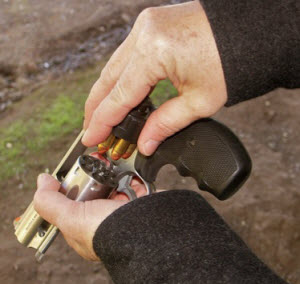

Share tips, start a discussion or ask other students a question. If you have a question for an expert, please click here.
Already a member? Sign in
No Responses to “Grant Cunningham”